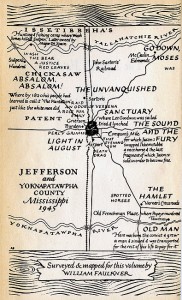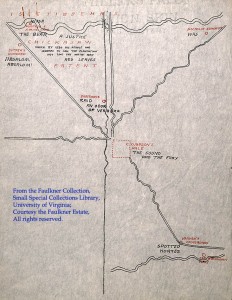Former Orlando Sentinel Books Editor Nancy Pate described William Faulkner’s Yoknapatawpha County as “[a] fictional landscape…peopled by rogues and rednecks, farmers and townsfolk, descendants of soldiers, slaves and carpetbaggers. There are whites, blacks, mulattos, people of all ages. They have names like Snopes and Sutpen, Compson and Bundren, Sartoris and Varner, Benbow and McCaslin. They live on old plantations and tenant farms, in small hamlets and crossroads smaller still. Their stories–many of them intertwining–make up what Faulkner called ‘the tragic fable of Southern history.'”
 Much like English novelist Thomas Hardy, whose “Wessex” is a fictional amalgam of real locations, Faulkner based Yoknapatawpha County on very real places. Faulkner lived for most of his life in Oxford, Mississippi. In Faulkner’s work, Oxford becomes the town of Jefferson, while the real Jefferson County is named “Yoknapatawpha” after the old Chickasaw word for the Yocona River south of town. The county is located in north central Mississippi not far from the Tennessee border. This 1947 map indicates the primary locations of several of Faulkner’s major works, including not only Light in August but also his masterworks Absalom, Absalom! and The Sound and the Fury.
Much like English novelist Thomas Hardy, whose “Wessex” is a fictional amalgam of real locations, Faulkner based Yoknapatawpha County on very real places. Faulkner lived for most of his life in Oxford, Mississippi. In Faulkner’s work, Oxford becomes the town of Jefferson, while the real Jefferson County is named “Yoknapatawpha” after the old Chickasaw word for the Yocona River south of town. The county is located in north central Mississippi not far from the Tennessee border. This 1947 map indicates the primary locations of several of Faulkner’s major works, including not only Light in August but also his masterworks Absalom, Absalom! and The Sound and the Fury.
 The second map, probably drawn in 1947 for Malcolm Cowley’s Portable Faulkner, is just one of a series that Faulkner created for each of his works. Characters, events, and locations in one work often make appearances in another. As such, many of the maps contain references not only to the current work, but other works that might have connections to it.
The second map, probably drawn in 1947 for Malcolm Cowley’s Portable Faulkner, is just one of a series that Faulkner created for each of his works. Characters, events, and locations in one work often make appearances in another. As such, many of the maps contain references not only to the current work, but other works that might have connections to it.
